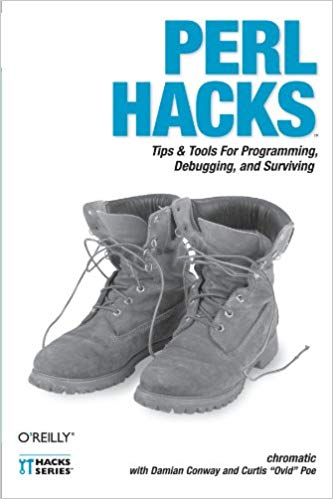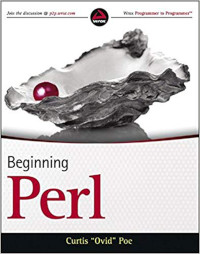Corinna in the Perl Core!
It’s been a years-long, painful process, but with the release of Perl v.5.38,0 , the first bits of Corinna have been added to the Perl core. For those who have not been following along, Corinna is a project to add a new object system to the Perl core. Note that it’s not taking anything away from Perl; it’s adding a core object system for better memory consumption, performance, and elegance.
If you don’t have v5.38.0, you can still install Feature::Compat::Class on Perl v5.14.0 and above and get the same features.
The MVP for the Perl core
is in seven stages, three of which are done and one of which (convenience
attributes) is started (there is a :param attribute for field).
- Classes (done)
- Inheritance (done)
- Roles
- Convenience attributes
- Field initializer blocks (done)
- MOP
- Method modifiers
We need at least six of those to be implemented to really have something decent out of the box, but the MOP, while important, is not something that most OOP developers reach for on a regular basis.
You can read what’s currently implemented at perldoc
perlclass , but here’s a 2D point
class using the existing features. We’ll make the default of the point be the
graph origin.
class Point::2D {
field $x :param = 0;
field $y :param = 0;
field $orig_x = $x;
field $orig_y = $y;
method x () { $x }
method y () { $y }
method reset () {
$x = $orig_x;
$y = $orig_y;
}
method move ($dx, $dy) {
$x += $dx;
$y += $dy;
}
method description () {
return "($x, $y)";
}
}
my $point = Point::2D->new( x => 10, y => 20 );
$point->move( 5, 5 );
say $point->description; # (15, 25)
When the full Corinna is implemented, the method x and method y will be
replaced with:
field $x :param :reader = 0;
field $y :param :reader = 0;
The Teams
Here’s a partial list of the main contributors and/or influencers to Corinna:
- Damian Conway
- Dan Book (Grinnz)
- Graham Knop (haarg)
- Harald Jörg
- Matt Trout
- Paul Evans
- Sawyer X
- Stevan Little
Note that Corinna was largely inspired by the work of Stevan Little. Damian Conway was also a huge contributor, but he was mostly behind the scenes sharing email with me and posting to blogs.perl.org ;
Sawyer X’s main contribution was being the pumpking who encouraged me to stop trying to implement Corinna, but instead focusing on building something great without worrying about the current limitations of Perl.
Paul Evans is doing the actual implementation work and he’s doing a fantastic job.
The others (not to slight them, I can’t remember all the details of a multi-year project) were also huge contributors. They helped suss out design flaws, called me on my bullshit, and helped me understand the limitations of what we were trying to accomplish.
It’s also worth noting that due to this team effort, Corinna is not what I wanted. I wanted more. Much more. But it wasn’t just about trimming Corinna down to what P5P would accept, it was also vetoing many of my ideas about what I thought should be in Corinna. I was wrong about a lot of things and I’m sure I’m right about about some others, but the team effort is what made Corinna what it is today and I’m immensely grateful for that.
Other Languages
In the process of developing the Corinna MVP, many other languages were looked at. I was particularly curious about Beta , but there was nothing that fit. I also looked at Smalltalk, Java, Raku, Python, Eiffel, and Ruby (and probably others I’m forgetting right now). There are many interesting ideas, but given that we were trying to get something that fit Perl, the biggest influences were Raku, Moo/se, and yes, Java. Primarily, I was interested in protected methods and inner classes, but the former seemed problematic and the latter wasn’t something appropriate for the MVP. However, reading about OOP design (so many examples are in Java), helped quite a bit with Corinna.
What We’re Losing
There are, of course, trade-offs in something this huge.
You Can’t Violate Encapsulation
The biggest concern amongst developers is that we can no longer violate encapsulation (well, you can via the MOP, but it will be more work, as it should be. Emergency patches sometimes require violating encapsulation).
However, I don’t know many developers who can define encapsulation. People keep saying it’s about hiding state, but that’s not true. It’s about hiding state and process because the two are intimately linked in classes. If you can change the state without going through the interface, you have no guarantees the process is correct. That’s a bad thing.
Fortunately, this has been well-understood for decades, so there’s a wealth of information about proper OOP design on how handle this. I expect there will be changes to Corinna to help with this, but we don’t know what they are yet.
No Multiple Inheritance
To my surprise, no one on the design team strongly argued against this change. There were discussions, but nothing too serious. There are many OOP languages which do not allow multiple inheritance and it’s not a big deal. In fact, there are some OOP language which don’t allow inheritance at all.
Most languages which forbid multiple inheritance offer some sort of alternative. In our case, it’s roles.
No Inheriting from Blessed Classes
Your new Corinna class cannot inherit from anything not declared as a class.
This was a slightly contentious issue, but there are simply too many
differences. Corinna doesn’t allow you to “reach inside” and manipulate the
data. Corinna is single-inheritance, so it’s unclear how that would have worked
with classes allowing multiple inheritance. And ultimately, we’d like Corinna to
have the option of having a different UNIVERSAL:: base class, offering
different capabilities.
This, of course, means that developers will have to understand “composition over inheritance.” This is a good thing.
What We’re Gaining
Object-oriented programming will be “first class” in Perl, not just a hacked on solution. Methods and subroutines will no longer be the same thing. We’ll have private methods. We already have a much more concise, and clear way of writing classes. Companies using the Object::Pad prototype have reported a 10% reduction in CPU usage and that’s without optimization. We have have potential for a much more efficient implementation of objects than we’ve had before.
The Principle of Parsimony
Given all of the above, I have confession to make about the new class syntax
for Perl: we made a mistake. It’s a whopping huge mistake.
The problem is that we don’t know what that mistake is. There’s probably more than one of them.
In the README of the Corinna repository is a section entitled The Principle of Parsimony , it states:
Many things in the proposal are deliberately restrictive, such as Corinna only allowing single inheritance. This is to allow Corinna to be cautious in not promising too much. If we later find this too restrictive, we can allow multiple inheritance. However, if we start with multiple inheritance and discover we don’t need or want multiple inheritance, we would break existing code by taking it away.
Any proposals to change the RFC must consider the principle of parsimony.
The design team really should have highlighted this more because it’s the
single most important thing (outside of the new class syntax itself).
Most people seem happy with the changes. They’re new. They’re exciting. They’re a step towards a new future for the language.
Some people are unhappy. Some are unhappy for reasons that are, well, silly. Case in point: I’ve had a developer angrily tell me they’re nearing retirement and they don’t want to keep up with a bunch of changes in the Perl language (more than one, but the other wasn’t quite so strident in this position).
Some are unhappy because Corinna didn’t go far enough.
Some are unhappy because Corinna has gone too far.
Others are unhappy because « insert reason here ».
I get that. I really do.
So why doesn’t Corinna have multiple inheritance? Because if it did and it’s a mistake, we can’t easily walk it back without breaking existing code.
So why doesn’t Corinna allow inheriting from non-Corinna objects? Because if it did and it’s a mistake, we can’t easily walk it back without breaking existing code.
So why doesn’t Corinna have native support for field (attribute) builders
like Moo/se? Because if it did and it’s a mistake, we can’t easily walk it back
without breaking existing code.
The counter-argument is that the new class syntax is experimental and we
should have that freedom. My counter-counter-argument is that I know of
large code-bases which haven’t upgraded past 5.26 because 5.28
swapped the order of attributes and signatures
bodies .
Companies can and do rely on experimental features.
The design team agreed (generally) to follow the Principle of Parsimony to ensure we didn’t paint ourselves into corners more than we already had. We expect that in the real-world, people are going to make compelling arguments for changes based on limitations they discover. We know mistakes are going to be found. We’d like to see if those are mistakes in our design, or mistakes in how people (ab)use OOP code in Perl.
I might add that the Principle of Parsimony hasn’t been an absolute, even in the design stage. For example, originally Corinna required a postfix block:
class Foo {
...
}
The extremely tight scoping of the postfix block would make it much harder for Corinna keywords to bleed into an unwanted scope. I argued for that, but I was overruled. The postfix block is not required.
So please keep this in mind about future discussions of the new class syntax.
We made mistakes. We don’t know what they are. We worked very hard to try to ensure that fixing those mistakes means extending Corinna, not breaking it.
Conclusion
Corinna, for now, is experimental and incomplete. The biggest obstacle for its
adoption is likely to be the fact that developers are going to have to learn new
ways of programming. The most annoying might be that field variables aren’t
available in subclasses (encapsulation!), so you’ll find it convenient to make a
public accessor to fetch this data. There’s a similar issue with roles. The Java
notion of protected methods is not available.
There are ways we could potentially address these issues, but we need to see what people are doing with Corinna and what their real pain points are.
Fortunately, the Object::Pad project shows that the new approach plays quite
well with existing code, so we are pretty sure we have the basics right, but we
don’t know what we don’t know.
Interesting times are ahead.


